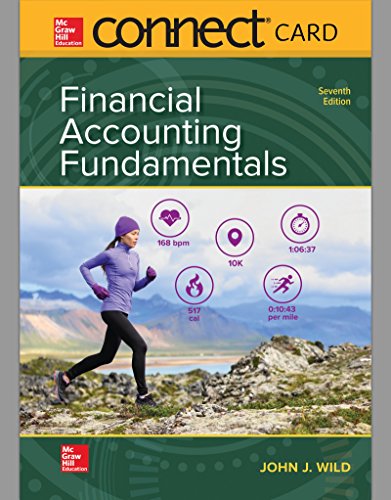
Concept explainers
1.
Compute cost of goods available for sale and the number of units available for sale.
1.
Explanation of Solution
Calculate cost of goods available for sale and the number of units available for sale.
| Cost of Goods Available For Sale | ||||
| Date | Particulars | Units (A) | Per Unit (B) | Amount (A× B) |
| Jan 1 | Beginning Inventory | 600 | $45 | $27,000 |
| Feb 1 | Purchase | 400 | $42 | $16,800 |
| Mar 13 | Purchase | 200 | $27 | $5,400 |
| Aug 21 | Purchase | 100 | $50 | $5,000 |
| Sep 5 | Purchase | 500 | $46 | $23,000 |
| Total | 1,800 | $77,200 | ||
Table (1)
Therefore, total cost of goods available for sale amount is $77,200, and the number of units available for sale is 1,800 units.
2.
Compute the number of units in ending inventory.
2.
Explanation of Solution
Calculate number of units in ending inventory as follows:
Working note:
Calculate cost of goods sold.
3.
Compute the cost assigned to ending inventory using the following methods:
- (a) FIFO
- (b) LIFO
- (c) Weighted average, and
- (d) Specific identification.
3.
Explanation of Solution
(a)
Compute the cost assigned to ending inventory using FIFO method as follows:
| Date | Particulars | Units (A) | Per Unit (B) | Amount (A× B) |
| Sept 5 | Ending Inventory | 400 | $46 | $18,400 |
| Total Ending inventory | 400 | $18,400 |
Table (2)
(b)
Compute the cost assigned to ending inventory using LIFO method as follows:
| Date | Particulars | Units (A) | Per Unit (B) | Amount (A× B) |
| Jan 1 | Ending Inventory | 400 | $45 | $18,000 |
| Total Ending inventory | 400 | $18,000 |
Table (3)
(c)
Compute the cost assigned to ending inventory using weighted average method as follows:
Working note:
Calculate weighted average per unit.
(d)
Compute the cost assigned to ending inventory using specific identification method as follows:
| Date | Particulars | Units (A) | Per Unit (B) | Amount (A× B) |
| Feb 10 | Ending Inventory | 100 | $42 | $4,200 |
| Aug 21 | Ending Inventory | 50 | $50 | $2,500 |
| Sep 5 | Ending Inventory | 250 | $46 | $11,500 |
| Total Ending inventory | 400 | $18,200 |
Table (4)
4.
Compute gross profit earned by the company for each of the four costing methods in part 3.
4.
Explanation of Solution
Calculate gross profit earned by the company for each of the four costing methods as follows:
| Particulars | FIFO | LIFO | Weighted Average | Specific Identification |
| Sales | $150,000 | $150,000 | $150,000 | $150,000 |
| Less: Cost of goods sold | $58,800 | $59,200 | $59,000 | $60,044 |
| Gross profit | $46,200 | $45,800 | $46,000 | $44,956 |
Table (5)
Working notes:
Calculate sales amount.
Calculate cost of goods sold.
| Particulars | FIFO | LIFO | Weighted Average | Specific Identification |
| Cost of goods available for sale | $77,200 | $77,200 | $77,200 | $77,200 |
| Less: Ending Inventory | $18,400 | $18,000 | $17,156 | $18,200 |
| Cost of goods sold | $58,800 | $59,900 | $60,044 | $59,000 |
Table (6)
5.
Identify the method of inventory costing which the manager will prefer, if he earns a bonus based on a percentage of gross profit.
5.
Explanation of Solution
The Manger would prefer a FIFO method, because comparing to all four methods FIFO method only giving more income. If he prefers, FIFO method means, he will get a bonus based on a percentage of gross profit.
Want to see more full solutions like this?
Chapter 5 Solutions
Connect Access Card For Financial Accounting Fundamentals
- Please explain the correct approach for solving this general accounting question.arrow_forwardPlease explain the correct approach for solving this general accounting question.arrow_forwardKayla Enterprises has sales of 45.8 million, total assets of 37.2 million, and total debt of $12.7 million. If the profit margin is 9 percent, what is the net income?arrow_forward

 AccountingAccountingISBN:9781337272094Author:WARREN, Carl S., Reeve, James M., Duchac, Jonathan E.Publisher:Cengage Learning,
AccountingAccountingISBN:9781337272094Author:WARREN, Carl S., Reeve, James M., Duchac, Jonathan E.Publisher:Cengage Learning, Accounting Information SystemsAccountingISBN:9781337619202Author:Hall, James A.Publisher:Cengage Learning,
Accounting Information SystemsAccountingISBN:9781337619202Author:Hall, James A.Publisher:Cengage Learning, Horngren's Cost Accounting: A Managerial Emphasis...AccountingISBN:9780134475585Author:Srikant M. Datar, Madhav V. RajanPublisher:PEARSON
Horngren's Cost Accounting: A Managerial Emphasis...AccountingISBN:9780134475585Author:Srikant M. Datar, Madhav V. RajanPublisher:PEARSON Intermediate AccountingAccountingISBN:9781259722660Author:J. David Spiceland, Mark W. Nelson, Wayne M ThomasPublisher:McGraw-Hill Education
Intermediate AccountingAccountingISBN:9781259722660Author:J. David Spiceland, Mark W. Nelson, Wayne M ThomasPublisher:McGraw-Hill Education Financial and Managerial AccountingAccountingISBN:9781259726705Author:John J Wild, Ken W. Shaw, Barbara Chiappetta Fundamental Accounting PrinciplesPublisher:McGraw-Hill Education
Financial and Managerial AccountingAccountingISBN:9781259726705Author:John J Wild, Ken W. Shaw, Barbara Chiappetta Fundamental Accounting PrinciplesPublisher:McGraw-Hill Education





